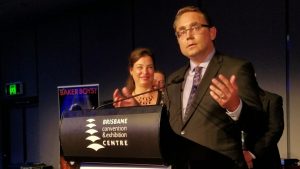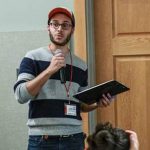Steven Schauer
San Antonio, Texas
Steven Schauer began his tenure at the San Antonio River Authority (River Authority) in January 2007 as the Manager of External Communications. In July 2017, Schauer was promoted to Director of External Communications where he oversees the Government Affairs Department and Brand & Public Communications Department. His work at the River Authority includes developing and implementing the strategic direction for the agency’s communication and outreach activities, acting as the River Authority’s spokesperson, coordinating local, state, and federal legislative and policy agendas, and directing the educational outreach programs. He also manages the River Authority’s national and international relations. Schauer has a Master of Public Affairs degree from the LBJ School of Public Affairs at the University of Texas at Austin and a Bachelor of Science in Environmental Science from Incarnate Word in San Antonio. One of the accomplishments Schauer is most proud of is kayaking the San Antonio River from the City of San Antonio to Seadrift, which was a 200+ mile paddling trip he also had the immense pleasure of filming to create two documentaries: Paddling Lessons and From San Antonio to Seadrift: Paddling the San Antonio River.
This interview was conducted by Carly Schmidt on September 10, 2021. Learn more about Steven and his work.
You recently worked with the River Network team on the National Water Reuse Action Plan (WRAP) grant. How did you get involved in this project?
We got involved through an invitation from [River Network CEO] Nicole. Because of our long working history with River Network, Nicole knew about the work we had done at the River Authority. In 2020, River Network was working with EPA to define the grant process and trying to determine which urban cities might make appropriate case studies. I looked at the proposal and knew right away that we wanted to be involved. The final report will be very helpful for us here, locally, and hopefully to others across the country as we examine ways to expand equity and our thinking around water issues.
What made the San Antonio River a good candidate for this partnership?
We have accomplished quite a bit already here in San Antonio. The River Walk is an established, known entity in terms of waterfront development. Over the last 20 years, we’ve expanded the historic River Walk and done some innovative work, particularly around ecosystem restoration. All of our projects involve a very large amount of citizen engagement. Part of the invitation to the WRAP grant process was to outline the work done here in San Antonio as a model for others to follow.
The River Authority was awarded the Thiess International Riverprize in 2017 due in part to this work, and we are happy to continue to share this information and hope it’s helpful for others, but we also identified shortcomings and areas for improvement. We certainly have areas in which we can grow and improve how we do our outreach and community engagement. The invitation was two fold: share your success story and learn how to make the model more equitable.

Steven Schauer accepting the Thiess International Riverprize in 2017.
Can you give us a sneak peek of this case study? What success have you had with your particular community engagement model?
We started the San Antonio River Improvements Project in 1998, which became a $384 million project to improve 13 miles in the urban core of the San Antonio River. We initiated a citizen and stakeholder committee called the San Antonio River Oversight Committee. Rather than having elected officials hand-pick the members, we identified organizations with distinct stakeholder interest in the river. These organizations were neighborhood associations, chambers of commerce, the archdiocese, nonprofit organizations, and others. We asked these groups to appoint members to the committee. This River Oversight Committee became the consistent voice for this project from 1998 through its completion in 2013. They created a master plan that defined the guiding principles of the project. This group was consulted every step of the way and we did not move forward until we had consensus.
What were some of the challenges with this model? I imagine that consensus was difficult given the range of technical expertise and priorities on the committee.
Yes, the committee members had a range of expertise and priorities but, ultimately, they were committed to building a project that everyone could be proud of. It was a challenge to explain the engineering and the more technical aspects of this project along the way. If the committee proposed an idea that wasn’t feasible from an engineering or funding perspective, [River Authority] staff took care to ensure that each member had a deeper technical understanding. Still, the committee remained deeply committed. They created their own subcommittee structure to dive deeper into certain portions of the project as well. Those subcommittees would learn and make recommendations. Our engineers earned the trust of the committee members by being patient and answering every question. Building that trust between the citizen committee and staff—and then maintaining that trust—was time-intensive but also critical to the process.
How did you maintain member engagement and trust over the 15-year (1998-2013) project?
Many committee members remained engaged over 15 years, but the participation structure was flexible. Organizations seated on the committee appointed a primary and secondary representative so they always had representation at the meetings. I think the fact that most committee members continued to show up for more than a decade is a testament to how they were being heard. They believed that they were really making a difference, and they were. [River Authority] made sure that each member was heard, we thoroughly explained the no’s [because of engineering or funding constraints], and tried to make the committee’s ideas work.
Also, instead of meeting in a conference room every time, we gave the committee regular tours of the project throughout the construction schedule. They were able to see the fruits of their labor. This often prompted more questions and discussions, but it was a very inclusive process and we’ve applied this model to other projects.
How are you applying this community engagement model to current projects?
We’re actually using this same successful community engagement model on two ongoing projects. The San Pedro Creek project, which is a nearly $200 million project, started in 2015 and is supposed to be finished by 2023. Our community engagement model helped us successfully navigate the challenges of having to stop the project in the middle of construction and create an entirely new design when the project unearthed the foundation of the first A.M.E. Church in San Antonio. The citizen stakeholders, including leadership and members of today’s A.M.E. Church, helped drive the new design process, which is incorporating into the project this important 1870s-era history of San Antonio’s first black church which consisted of freedmen and formerly-enslaved people who were seeking religious freedom and a place where they could establish a community following emancipation after the Civil War. We are also using the same citizen oversight committee model on the Westside Creeks Restoration Project. The Westside Creeks is our next major ecosystem restoration project, which we just got into President Biden’s budget as an urban core project with many environmental justice considerations. It involves restoration of multiple creeks through the West side of San Antonio that includes a low-income community. Finally, with the Biden-Harris Administration, we have leadership that understands the benefits of these types of urban waters projects.
How do equity and environmental justice objectives show up in this model?
We are considering how this project may drive housing prices and displacement. We’ve been advocating for 10-15 years for Federal funding for these projects that prioritize flood control and ecosystem restoration in urban communities. We want to provide flood mitigation, ecosystem restoration, water quality improvements, and recreational amenities for lower-income communities so area residents can have access to all the health and economic benefits that come with having safe places to be outside. We’ve learned over the years that when developing these impactful ecosystem restoration projects in lower-income communities, we should also concurrently address issues such as workforce development, small business enterprises, and affordable housing. The San Antonio River Authority, using our citizen oversight committee model, will lead the community discussions around the ecosystem restoration project, and we will collaborate closely with the City of San Antonio and Bexar County to help develop in tandem an equitable development plan to address displacement, potential property tax increases, and other equity related issues that are outside the jurisdiction of the River Authority but are critical to the success of the restoration project. There is a lot of work ahead of us but these issues are top-of-mind as we move forward with the development of this project.
What does it mean to direct the San Antonio River Authority’s external communications?
I’ve been at the River Authority for almost 15 years. I began as a manager of external communications. At that point, the agency didn’t have an external communications department. I was a PR consultant at that time after having served the mayor of San Antonio and Governor of Texas, and Lt. Governor prior to that. The new department was me and three other people. Now, 15 years later, I’m the director of external communications and there are 15 others in the division, which includes the government affairs department and the brand and public communications department. We host 100s of events and activities throughout the basin each year and do a considerable amount of K-12 education, including 100 field trips a year. Essentially, the external voice of the River Authority flows through this division.
No one could have foreseen all the international opportunities that have come to the River Authority since 2007. I am very grateful and fortunate to have had the opportunity to travel the globe and speak at various conferences, including River Rally! I work very closely with the City of San Antonio’s global affairs staff due to the significant number of international visitors who are interested in how we’re developing and restoring the river. I am regularly having conversations with folks around the world to share data and tell them what has worked for us. It is also important for me to learn from them. We’ve had a lot of great successes to talk about, but there’s so much good work happening around the world. I enjoy these exchanges immensely and learning from others is my favorite part of what I do.
It’s hard to believe that SARA didn’t have a communications team prior to 2007!
The River Authority was created in 1937 to channelize the San Antonio River from San Antonio to the Gulf Coast—240+ miles! Fortunately, this was not feasible and the agency shifted in the 1960s to focus on flood control and environmental restoration. As an agency, there wasn’t really a need for an external voice because the work was primarily with other governments. It was really in the early 2000s, under the leadership of then-General Manager Suzanne Scott. She envisioned an agency that was much more integrated into the community than we had previously been.
What impact would you like to have in your community, and perhaps globally, in the next 5-10 years?
With the success of the Mission Reach Ecosystem Restoration and recreation project that we built here in San Antonio, I would welcome the opportunity to continue to share what we’ve learned with communities around the country and around the world. This project is really demonstrating that, in an urban environment, you can have recreation; a native ecosystem; and a river that can function for flood management. We’ve proven that this can be done. Just south of the urban core of the seventh largest city in the nation, we have a thriving ecosystem that citizens are enjoying in droves. We’ve identified 206 different bird species using the restored habitat, we’re reestablishing native fish species, and we’re the first in the State to re-introduce native freshwater mussels back into a Texas river. I would be just thrilled if, in the next 5 to 10 years, I could be a Johnny Appleseed of sorts and help communities understand that a healthy ecosystem within the confines of a large urban environment can be done if the citizens and the political will are there.







